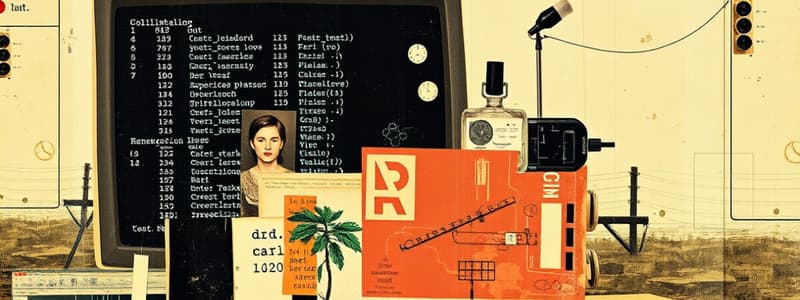Podcast
Questions and Answers
What is a key characteristic of a computer program?
What is a key characteristic of a computer program?
- It does not require a programming language.
- It consists of a sequential set of instructions. (correct)
- It relies on graphical interfaces exclusively.
- It can execute commands in any random order.
What does programming primarily enable a user to do?
What does programming primarily enable a user to do?
- Create graphics for video games.
- Instruct computers to perform tasks. (correct)
- Manage network security.
- Understand hardware configuration.
Which programming paradigm emphasizes organizing code into reusable procedures?
Which programming paradigm emphasizes organizing code into reusable procedures?
- Procedural Programming (correct)
- Object-oriented Programming
- Functional Programming
- Declarative Programming
What was the initial form of programming?
What was the initial form of programming?
Which programming paradigm is primarily associated with encapsulating data and behavior within objects?
Which programming paradigm is primarily associated with encapsulating data and behavior within objects?
Which skill does programming help enhance?
Which skill does programming help enhance?
What type of programming language operates closer to machine code?
What type of programming language operates closer to machine code?
Why is proficiency in programming considered valuable in various industries?
Why is proficiency in programming considered valuable in various industries?
What distinguishes functional programming from procedural programming?
What distinguishes functional programming from procedural programming?
Which programming language is widely known for its object-oriented programming features?
Which programming language is widely known for its object-oriented programming features?
Flashcards are hidden until you start studying
Study Notes
Programming Basics
- A computer program consists of a sequential set of instructions (code) written in a computer language to perform specific tasks.
- Examples of software types include system software, web browsers, utility software, multimedia software, and spreadsheet software.
- Instructions must be performed in a sequence unless specified otherwise.
Definition of Programming
- Programming is the art and science of instructing computers to perform tasks using a programming language.
- It allows for the creation of codes to solve problems, develop software applications, design websites, analyze data, and automate processes.
- Proficiency in programming leads to career opportunities in software development, web development, data science, and artificial intelligence.
- Enhances skills such as critical thinking, logical reasoning, and problem-solving.
Evolution and History of Programming
- Initially, programming involved writing machine code consisting of binary instructions (0 and 1).
- High-level programming languages emerged to simplify coding through human-readable syntax.
- A wide variety of programming languages and tools now exist to address various application domains and paradigms.
Programming Paradigms
- Procedural Programming: Focuses on reusable procedures/functions; emphasizes the sequence of steps. Common languages include BASIC, C, C++, Pascal, and Java.
- Object-Oriented Programming (OOP): Centers around objects encapsulating data and behavior, promoting modularity and code reusability. Examples are Python, VB.NET, and C#.
- Functional Programming: Treats computation as evaluating mathematical functions; values consistency and minimizes side effects.
Programming Languages
- Low-level Languages: Close to machine code; offers direct hardware control for precise execution. Examples include Assembly Language and Machine Language.
- High-level Languages: Easy for humans to read and write; abstracts hardware details. Examples include C++, Pascal, PHP, Python, and Java.
- Language choice depends on project requirements, performance needs, community support, and available libraries/frameworks.
Key Programming Terminologies
- Syntax: Rules defining valid combinations and arrangements in a programming language.
- Command: Unique instruction for tasks, e.g., "print" for displaying text.
- Integrated Development Environment (IDE): Software applications for formatting, checking syntax, and testing code; can support multiple languages.
- Library: Collection of pre-built resources (objects and functions) for use in programming.
- Interpreter: Directly executes high-level language instructions without translating them to machine language.
- Assembler: Converts low-level assembly instructions into machine language.
- Compiler: Converts high-level programming code into machine-readable code.
Algorithms, Pseudocode, and Flowcharts
- An algorithm is a set of steps leading to problem solutions, expressed in simple language.
- Example algorithm for calculating the volume of a rectangle involves steps to get dimensions, compute the volume, and display the result.
- Problem-solving steps in programming include:
- Problem Analysis
- Algorithm Design
- Coding
- Execution
Flowchart Creation Rules
- Use standard symbols only.
- Logic must flow top to bottom and/or left to right.
- Each symbol should have one entry and one exit point, except decision symbols.
- Operations in symbols should be independent of programming languages.
- Decision branches must be clearly labeled.
Studying That Suits You
Use AI to generate personalized quizzes and flashcards to suit your learning preferences.




